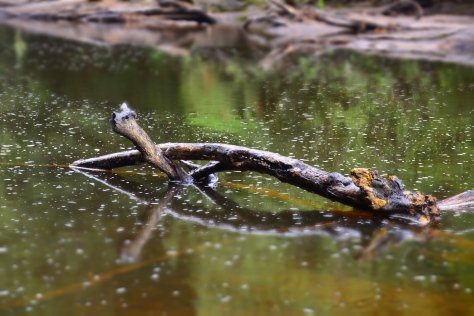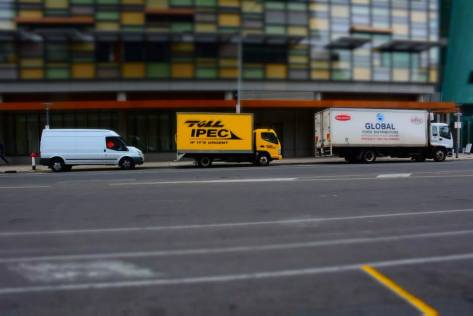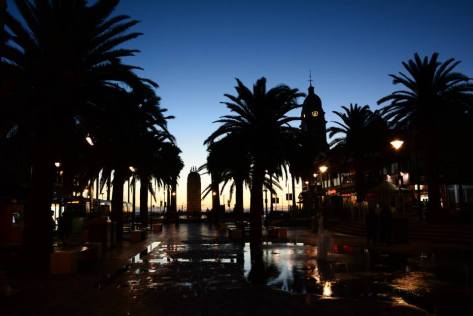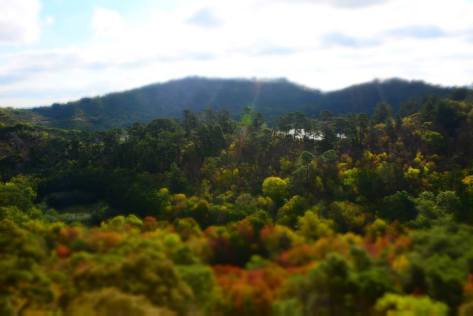The third night was bittersweet. It was hard to believe I’d be back in an office in two days, in a concrete city with steel bridges and stone arches, wearing all my manufactured things and surrounded by stuff. I was already asking myself, how can I come back here? How can I fix my life up so I can come back and do an expedition trip in the Tarkine? I slept with my camera battery as usual that night, clutching it as though it were the images I had taken that day. My camera gives me a purpose in places, and it helps me get through the leaving part of every departure, knowing I take something of the places with me.
In the morning we woke up and ate muesli and yogurt and toast. I’ve been eating muesli and yogurt for breakfast ever since, psychoanalyze that for what you will.
Everyone was happy and cheerful around the big wooden table, seated on big wooden benches. We were up especially early because it would be a long day back to Hobart. Everyone was all packed and ready to start off down the track to the van when someone realized Phun and David were missing.
We had made it all that time with no incident, and now on the very last day someone had to get lost, I thought! It was easy enough to do– the forest all looked the same and was so tall you could never see a marker to get your bearings.I could barely make it from the kitchen to my tent at night without panicking I’d missed a turn.
Trevor called for Phun, at first using her name and then switching to yelling COO-WEE! COO-WEE! COO-WEE! A sign of three– three calls, three sticks in a path, three of anything, is a sign of distress in Australia.
No one answered.
Daniel went to check near the shower, while Gerry and Trevor hiked back to David’s tent, as he had the farthest accommodation and was pretty darn isolated. Daniel came back and shrugged his shoulders, no sign.
Finally Trevor and Gerry returned, chatting to one another as they walked up the path, and someone, Kate I think, from our little gathered group of hikers, asked, “Well?”
“All good,” returned Trevor. But it was very vague, for a disappearance explanation, and Kate pressed further. “David was having a little trouble rolling up his sleeping bag,” Trevor said, and his gaze fixated on mine in one of those silent communication deals I’ve always been real terrible at. But I sensed I ought to add something, for some unknown reason, so I said, “Yeah I had trouble with mine too. It’s hard to stuff it in the bag.” Which is too right.
Anyway, we all started off on our walk, with Phun and David tagging in behind us once they caught up. I savored my last minutes beneath the shaded canopy.
What is it about sunshine that makes it sparkle? Is it just something in the eye’s of the beholder?
As we walked ever closer to the van, to our departure point from this magical place, I couldn’t help but wonder at how everything was glowing and golden and shining. Every word for light that we have, the forest was doing that.
I don’t want to wax poetic to much here, but it was happening inside me too. I felt light. There is a reason we have the same word for weightlessness that we do for illumination, and I could feel a beautiful, feather-like, airy, bright sensation inside me.
I think what happened there was my soul came to the very surface of me, and for once my mind wasn’t dominating everything, and my body signals of ouch-that-was-a-big-rock-dummy and oh-I-love-to-stretch faded into a far distance, and like I said, that shining, buoyant, ethereal, cloudless (emotion? state of being? transcendence?) took over.
And then we were back at the van loading our luggage and stripping off layers and trying to find real world objects like our money and cell phones and driver’s licenses.
We drove to a place called Warratah, which was a little dying town where almost nobody lived, and there was once questionable looking server, Australian for a gas station, where Trevor pulled the van into and announced we would be ordering our lunch from. I inwardly groaned, this place looked like bad news to me.
We piled out of the van and we all ordered a burger with “the lot.” The lot consists of a lot of things to try and hide the old, greasy taste of poor quality meat. Gross. I hate to talk about it, really. I did insist they leave the egg of my hamburger. I simply cannot be eating eggs on my hamburger. It’s just not right.
After placing our order and telling Susie we would return at 12:30, we got back in the van and drove a little ways to the entrance of a walk to Philosopher’s Falls. James Philosopher had discovered a gigantic tin mine as Tasmania’s economy was collapsing in the late 1800’s, and for twenty years the mine had been the most prosperous tin mine in the world and employed lots of people. Then it dried up and closed, but continued leaking sulphuric toxins into the water supply and land for a solid hundred years, and is still leaking. It cost the government more to try to clean the whole mess up than the entire amount of precious metals was worth that was hauled from it during the life of the mine.
This is just a classic example. Lots of industry is just a wolf in sheep’s clothing. You can focus on creating jobs all you want, but if you have to create a job at the expense of future lives, is it still worth it? Of course it isn’t. 1 in 2 Tasmanian men will get some form of prostate cancer, Trevor told us. 1 in 2.
Even from a business perspective, purely focused on money, the mine wasn’t a good idea because it ended up costing so much more than it was worth.
But anyway, these falls were named after James Philosopher, and we began our walk down to them in the rain. It was beautiful, of course. It was also really easy, as there was an actual maintained trail, complete with 207 steps down to the waterfall. One minor oversight of whoever had built the trail was the material used for the steps, which proved to be ridiculously slippery. Trevor told us after the trail was built, it had to be closed for a year because neither the parkland management nor the forestry division wanted to be liable for falls and injuries.
Thankfully none of us fell or were injured, and I got a great picture of the waterfall! It was pretty big and roared down to depths we couldn’t see because of the foliage. Great clouds of mist drifted off of it.
We hiked back up, went back to the server’s, ate our questionable hamburgers (I could only bear to eat half of mine, and I was so hungry), and then found ourselves back in the van. The ride home was silent. When we got out at the Elizabethtown bakery to get coffees and stretch Daniel came over to me.
“It’s a weird part of the journey,” he said, “isn’t it?”
It sure is. I had only known these people for four short days, and even now I didn’t really know them, and yet we had all shared a unique experience with each other. The Tarkine had met something different to each of us, and what we took from the Tarkine would be different, but across all of our individualities lay a universal emotion for the place, an indescribable connection.
On the way home Trevor played Tom Waits and Modest Mouse (below, for you to sample).
https://www.youtube.com/watch?v=CTAud5O7Qqk
And one by one our little party disbanded in reverse, until it was just me, Penny, Gerry and Kate, Trevor, Daniel, and Phun bound for Hobart. The moment we unloaded my luggage I was incredulous it was over. Such is time.
The rest of the trip is mundane. I ate more fish and chips, I walked the city, I wrote postcards, and then I boarded a delayed plane (of course) and flew home to Adelaide, where I found a dirty kitchen and scrambled room from my frantic departure. I sighed. Real life is very disenchanting sometimes.
The next day I went to work.
I can’t tell you how thankful I am I had the opportunity to go to the Tarkine. Sometimes in the wondrous moments of life (and I’ve had so many lately) I stand and feel bewildered that not only are all the good decisions I’ve made, all the good things I’ve done, and all the good people I’ve met part of the reason I’m there, but that the sad things that have happened are just as much part of the reason that I made it there.
Not that my life is a story of tragedy by any means, but I think the important thing that I’m trying to say is, when you find some incredible moment in the world, as long as you’ve tried to make it to that moment, as long as you’ve done your best, as long as it’s all in good faith– the mistakes are forgiven, the sad things fade, and reward will come– and it won’t be what you planned, probably, but it’ll likely be even better, and maybe you won’t have any idea what it will look like or what you’re searching for, but it will find you as long as you don’t give up on searching for it.
If you had told me, one year ago, five years ago, ten years ago, that I would stand in the Tarkine in Tasmania, Australia and have a quiet moment amongst the trees I would have thought that was a little far out there, extremely unlikely, just a fantasy or a dream that I’d never fantasized or dreamed of yet.
But I was there.
And it was a miracle. Life is a miracle.




